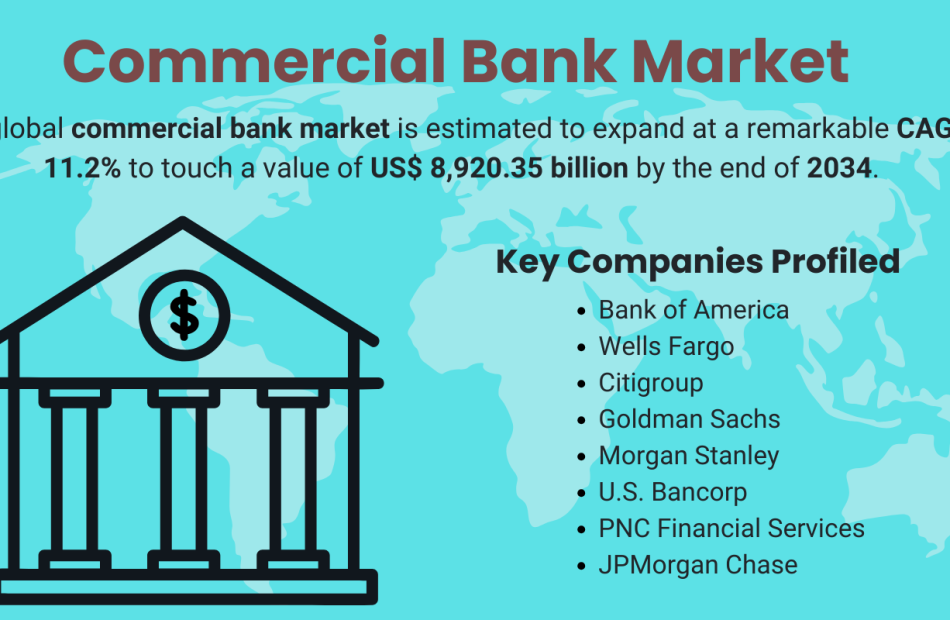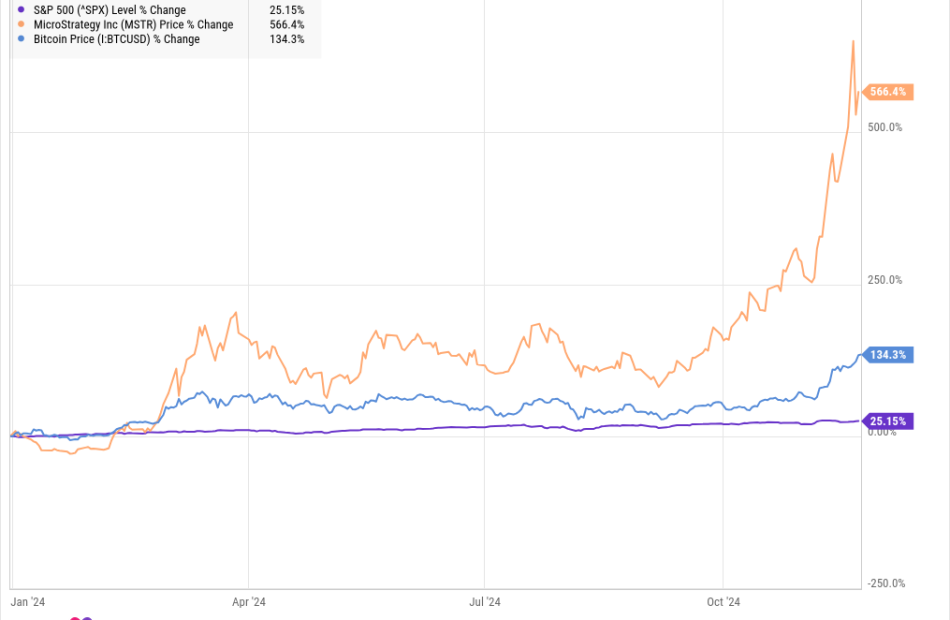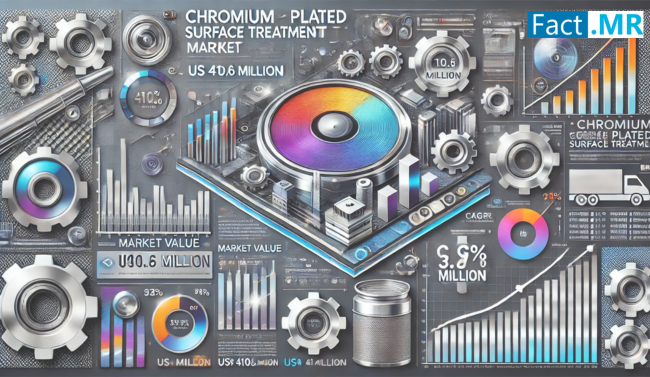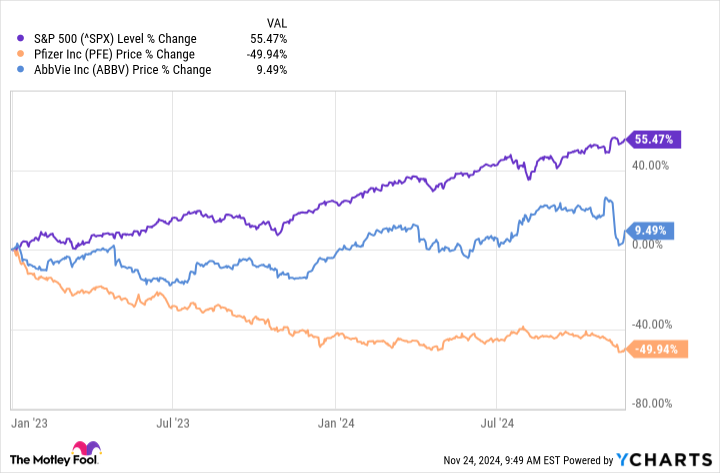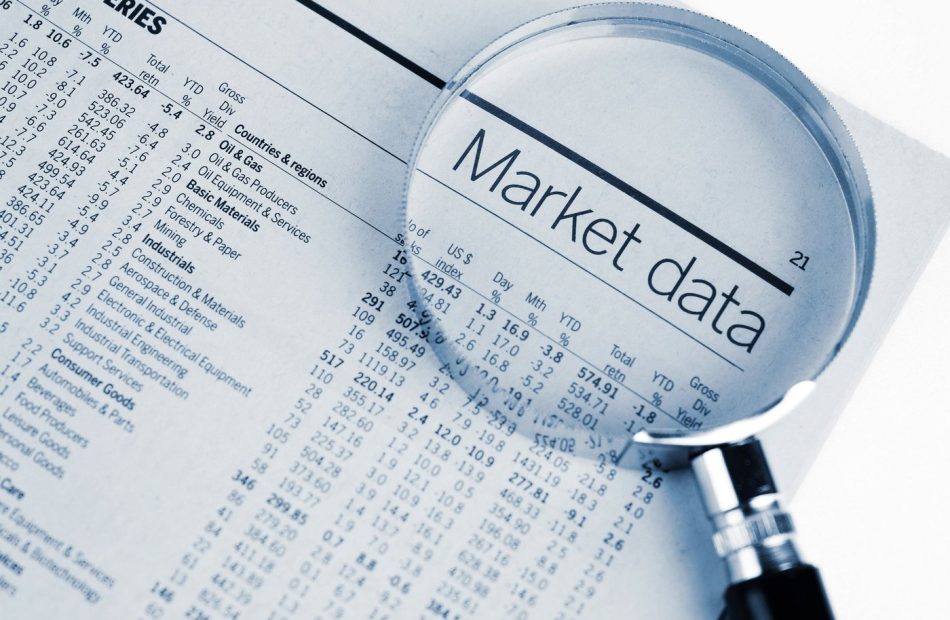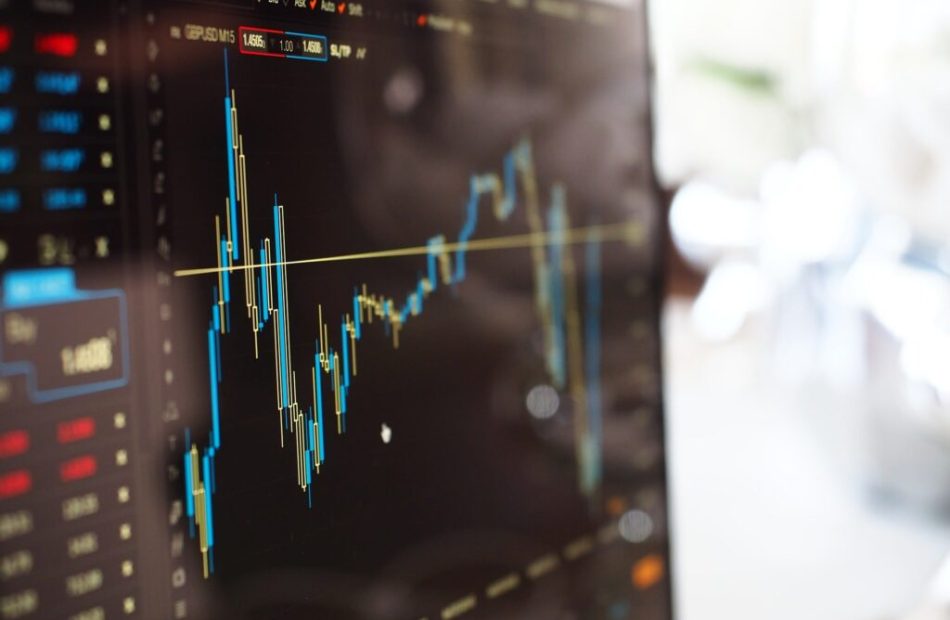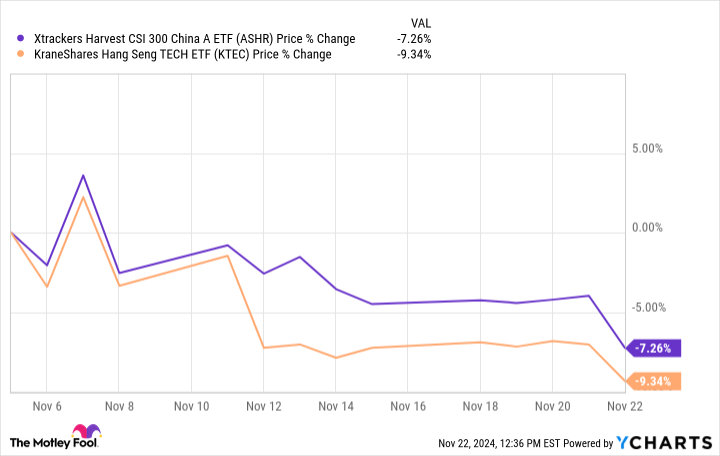Commercial Bank Market is Poised to Grow at 11.2% CAGR, Surpassing US$ 8,920 Billion by 2034 | Fact.MR Report
Rockville, MD , Nov. 26, 2024 (GLOBE NEWSWIRE) — The global commercial bank market is estimated to generate revenue worth US$ 3,093.42 billion in 2024 and has been thoroughly analyzed to expand at a remarkable CAGR of 11.2% to touch a value of US$ 8,920.35 billion by the end of 2034.
Commercial banks are constantly extending their products in asset management, financial planning, retirement services, and other areas in response to the rising demand for wealth management and investment services. Banks are tapping into a profitable industry by meeting with individuals and businesses searching for tailored financial solutions. Another reason driving this trend is a higher interest in diverse assets and comprehensive financial planning, which is forcing banks to strengthen their digital advising tools and personalized services to better serve their changing customer.
The North American region is projected to hold significant market share and lead throughout the assessment period. North America is leading due to its stability and fierce competition between traditional banks and fintech companies. Large investments in technology are driving digital banking services, and banks are increasingly focusing on improving operational efficiency and customer experience.
For More Insights into the Market, Request a Sample of this Report: https://www.factmr.com/connectus/sample?flag=S&rep_id=10486
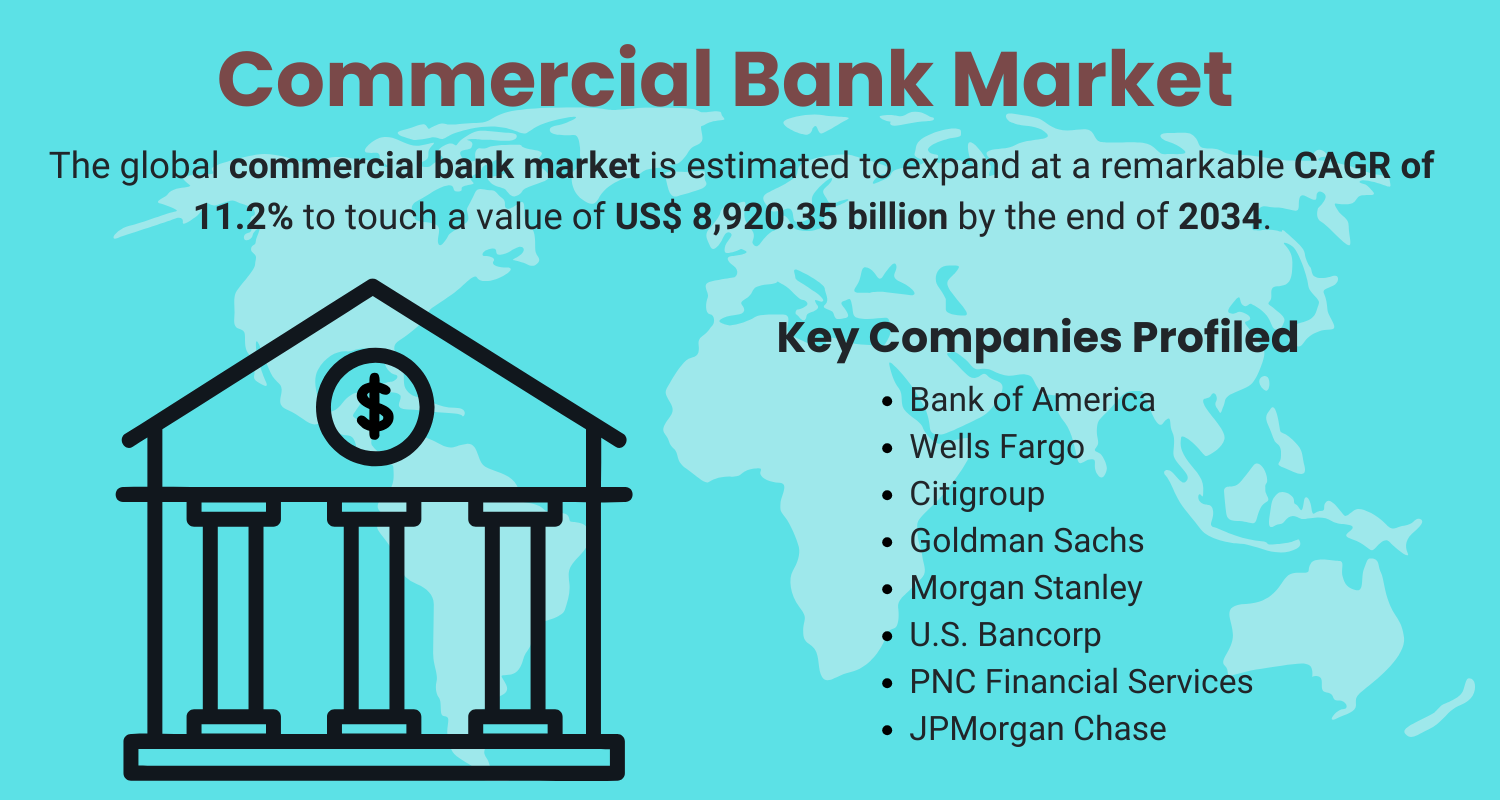
Key Takeaways from Commercial Bank Market Study:
- Revenue of the global market for commercial banks is forecasted to reach US$ 8,920.35 billion by 2034.
- North America is analyzed to generate a turnover of US$ 425.4 billion in 2024.
- The market in South Asia & Pacific is evaluated to increase at 13.9% CAGR between 2024 and 2034.
- The market in Japan is estimated to reach a value of US$ 467.06 billion by the end of 2034.
- China is approximated to register revenue of US$ 631.22 billion by 2034.
- The market in the United States is forecasted to expand at 12.4% CAGR from 2024 to 2034.
- Based on product and service, the Commercial & Industrial Mortgages segment is projected to reach a size of US$ 3,188.67 billion by 2034.
“Prominent commercial banks are investing in advanced digital technology to enhance the client experience and operational efficiency. Banks are emphasizing reducing costs while attracting tech-savvy customers, resulting in greater transaction volumes and service usage,” says a Fact.MR analyst
Commercial & Industrial Mortgages Segment Hold a Sizable Revenue Portion
Compared to other products and services, commercial and industrial mortgages are in high demand. To increase assets and profitability, several businesses are investing more in new machinery, infrastructure, real estate, and other items. This trend is particularly apparent in sectors, including manufacturing, logistics, technology, and others where space and resources are critical for growing operations. Moreover, low interest rates in several locations have made borrowing more alluring and encouraged businesses to seek out capital for real estate acquisitions. The demand for commercial and industrial mortgages is rising as businesses look to maximize their infrastructure and secure excellent locations.
Leading Players Driving Innovation in the Commercial Bank Market:
Bank of America; Wells Fargo; Citigroup; Goldman Sachs; Morgan Stanley; U.S. Bancorp; PNC Financial Services; JPMorgan Chase; HSBC; Deutsche Bank; BNP Paribas; Royal Bank of Canada; Santander; Barclays; Metropolitan Commercial Bank
Commercial Bank Industry News:
In September 2024, Metropolitan Commercial Bank, a full-service commercial bank headquartered in New York City, announced the introduction of its new and enhanced website, MCBankNY.com. By emphasizing user experience and accessibility, the new website strives to provide seamless and convenient banking to the bank’s loyal clients and partners.
Get Customization on this Report for Specific Research Solutions- https://www.factmr.com/connectus/sample?flag=S&rep_id=10486
More Valuable Insights on Offer
Fact.MR, in its new offering, presents an unbiased analysis of the commercial bank market, presenting historical demand data (2019 to 2023) and forecast statistics for 2024 to 2034.
The study divulges essential insights into the market based on product & service (commercial & industrial mortgages, other business loans, residential mortgages, home equity & vehicle loans, other secured & unsecured consumer loans, government loans) and major market (consumers, other businesses, manufacturing companies, transportation, storage & postal service companies, wholesale & retail companies, utility companies, real estate companies, government clients), across seven major regions of the world (North America, Western Europe, Eastern Europe, East Asia, Latin America, South Asia & Pacific, and MEA).
Checkout More Related Studies Published by Fact.MR Research:
The global management consultant market is valued at US$ 936.85 billion worth in 2024. Further, advancing at a CAGR of 10.9%, the market is approximated to reach a valuation of US$ 2,655.14 billion by 2034.
The global management consulting services market is expected to be worth US$ 298.6 billion in fiscal year 2023, up from US$ 285.0 billion in fiscal year 2022. From 2023 to 2033, the market is expected to grow at a 4.8% CAGR, reaching a value of US$ 477.3 billion by the end of 2033.
The global management system certification market is expected to reach US$ 29 billion in 2024, as revealed in the updated research report by Fact.MR. Revenue from management system certification services is evaluated to increase at 4.8% CAGR and reach US$ 46.3 billion by 2034.
Integrated Talent Management Market based on functionality(Talent Acquisition ,Performance Management ,Learning Management ,Compensation ,Succession and Leadership Development ,Workforce Planning) – Global Review 2018 to 2028
Relational Database Management Systems Market By Deployment (On-premise, Cloud-Based), & By Region (North America, Latin America, Europe, CIS & Russia) – Global Market Insights 2023 to 2033
About Us:
Fact.MR is a distinguished market research company renowned for its comprehensive market reports and invaluable business insights. As a prominent player in business intelligence, we deliver deep analysis, uncovering market trends, growth paths, and competitive landscapes. Renowned for its commitment to accuracy and reliability, we empower businesses with crucial data and strategic recommendations, facilitating informed decision-making and enhancing market positioning. With its unwavering dedication to providing reliable market intelligence, FACT.MR continues to assist companies in navigating dynamic market challenges with confidence and achieving long-term success. With a global presence and a team of experienced analysts, FACT.MR ensures its clients receive actionable insights to capitalize on emerging opportunities and stay ahead in the competitive landscape.
Contact:
US Sales Office:
11140 Rockville Pike
Suite 400
Rockville, MD 20852
United States
Tel: +1 (628) 251-1583
Sales Team: sales@factmr.com
Follow Us: LinkedIn | Twitter | Blog

© 2024 Benzinga.com. Benzinga does not provide investment advice. All rights reserved.
Short-Seller Andrew Left Slams MicroStrategy. Is Michael Saylor's Bitcoin Stock in Trouble?
MicroStrategy (NASDAQ: MSTR) has become one of the most valuable stocks on the Nasdaq by pursuing a simple strategy: buying Bitcoin (CRYPTO: BTC).
The stock has soared alongside Bitcoin’s gains this year, which have come with the broader bull market, the launch of spot Bitcoin exchange-traded funds (ETFs), and optimism that a new Trump administration will adopt crypto-friendly policies. As you can see from the chart below, both MicroStrategy and the cryptocurrency have surged this year.
Are You Missing The Morning Scoop? Wake up with Breakfast news in your inbox every market day. Sign Up For Free »
MicroStrategy is unique on the stock market because it essentially acts like a leveraged Bitcoin ETF. Chief Executive Officer Michael Saylor, one of the biggest evangelists for the digital coin, began buying it for his company in 2020, and it held 252,220 bitcoins as of the end of the third quarter.
However, one well-known short-seller is now saying MicroStrategy is overvalued and that its model is unsustainable. Andrew Left of Citron Research posted his thesis on X, saying that while his company was bullish on MicroStrategy in 2020 as a way to invest in Bitcoin, it had now reversed its position.
Citron said that MicroStrategy’s value has completely detached from the crypto’s performance. Citron noted that it was still bullish on Bitcoin but was hedging that bet with a short position in MicroStrategy.
The company’s stock plunged 16% last Thursday when Citron published its short report.
Left is correct that MicroStrategy’s fundamentals have become detached from Bitcoin’s value. It does have a small software business, but it’s basically negligible as far as its valuation is concerned — its market cap was $94.8 billion as of Nov. 22. It now identifies itself as a Bitcoin treasury company.
But its Bitcoin holdings don’t justify that valuation, either, because based on its market cap and those holdings, the company is valued at $375,864 per token, which is nearly four times the price of the cryptocurrency — $98,807 — at the time of writing. The value of the Bitcoin held on its balance sheet is now $22.4 billion.
Currently, MicroStrategy is sitting on a gain of $49,441 per Bitcoin, with an average purchase price of $39,266. In total, it has gained $12.5 billion from its Bitcoin purchases.
The company also has $4.2 billion in long-term debt as it continues to borrow money and sell stock to buy the crypto.
MicroStrategy trades like a leveraged Bitcoin ETF because the company is consistently increasing exposure to the crypto, which effectively makes it an outsized bet on Bitcoin going up. Holding Bitcoin directly or through an ETF doesn’t allow you to do that, as the exposure is steady.
Chromium Plated Surface Treatment Market is Expected to Grow 3.8% CAGR with US$ 410.6 Million by 2034 | Fact.MR Report
Rockville, MD, Nov. 26, 2024 (GLOBE NEWSWIRE) — The chromium plated surface treatment market is expected to grow from US$ 283.1 million in 2024 to US$ 410.6 million in 2034. Fact. MR’s extensive study shows that the market will expand at a growth rate of 3.8% from 2024 to 2034.
The rising world demand for chromium plated materials is closely associated with the market requirement for lightweight and durable materials in aerospace. This is due to the choice of materials like aluminium, titanium, and composites to reduce aircraft weight which in turn increases aircraft fuel efficiency and reduces carbon emission. But these benefits are compromised as these materials need stronger treatments to make them resistant to damage; they have to withstand wear and tear. Coincidentally, the use of technologies such as chromium plating in processes like ion vapor deposition (IVD) and high velocity oxygen fuel (HVOF) grinding has been advanced.
With an intense desire to make aviation systems more effective, and address the issue of fuel efficiency and preservation of the environment among others, there is a big investment in surface treatments. The importance of chromium plating technologies is seen in the enhancement of mechanical properties of the ultralight materials. These enhancement enables their application in high stress components such as the landing gear, fasteners, and the engine stators. In addition, the increase in the production of commercial aircraft and military aircraft, as well as the investment in new designs of aircraft, also enhances the need for coatings, hence increasing the market.
For More Insights into the Market, Request a Sample of this Report:
https://www.factmr.com/connectus/sample?flag=S&rep_id=10461
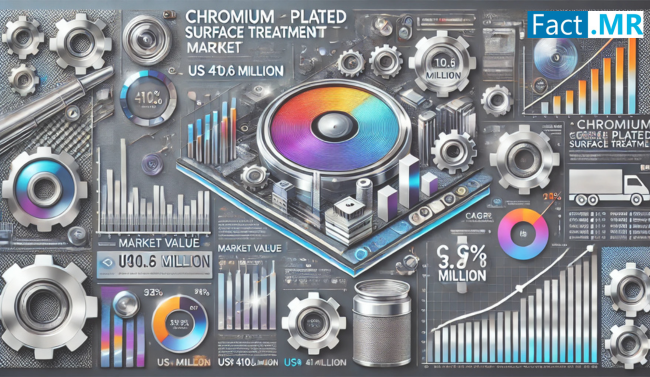
Key Takeaways from Market Study:
- Global chromium plated surface treatment market will grow at a CAGR of 3.8%, reaching US$ 410.6 million by the end of 2034.
- North America will expand at a CAGR of 3.9% from 2024 to 2034, capturing 26.8% of the market share in 2024 and offering an absolute opportunity of US$ 35.5 million.
- East Asia will account for 18.8% of market share in 2024, generating an absolute dollar opportunity of US$ 24.0 million between 2024 and 2034.
- Between 2024 and 2034, by plating technology the electroplating are expected to produce an absolute dollar opportunity US$ 43.1 million.
- With a 37.0% market share, by end user, commercial aircraft manufacturers segment is estimated to be worth US$ 104.7 million in 2024.
“Increasing environmental regulations, shift toward sustainable technologies and growing demand in military aerospace applications have contributed to the growth of the chromium plated surface treatment market” says a Fact.MR analyst.
Leading Players Driving Innovation in the Chromium Plated Surface Treatment Market:
Atotech; Valence Surface Technologies; Electro-Coatings, Inc.; Pioneer Metal Finishing; Hard Chrome Specialists; Bales Metal Surface Solutions; KOCH Finishing Systems; Advance Plating Technologies; Multinal Group; CZL Tilburg; Embee Processing; John Cockerill Surface Treatment; Betz-Chrom; ASCO Engineering & Surface Technology; Hardide; New Method Plating Inc.; Precision Industries, Inc; Hayden Corp.; G.W.P. AG; DVS Enterprises; Other Prominent Players
Market Development:
Key companies involved in chromium plated surface treatment market are Atotech, Valence Surface Technologies, Electro-Coatings, Inc., Pioneer Metal Finishing, Hard Chrome Specialists, Bales Metal Surface Solutions, KOCH Finishing Systems, Advance Plating Technologies, Multinal Group, CZL Tilburg, Embee Processing, John Cockerill Surface Treatment, Betz-Chrom, ASCO Engineering & Surface Technology, Hardide, New Method Plating Inc., Precision Industries, Inc, Hayden Corp., G.W.P. AG, and DVS Enterprises.
These companies in the chromium plated surface treatment market focuses on innovation, sound environmental practices, strategic partnership building, and expanding their product lines to improve performance and meet growing demand in many industries.
As an instance-
- In August 2023, Sharretts Plating adopted the enhancements in chrome-plating technologies with a focus on environmental sustainability. The improvement seeks to reduce the use of hazardous chemicals while maintaining high-quality surface treatments.
- In July 2022, Pioneer Metal Finishing signed a partnership with Allied Metal Company on the development and expanding capabilities and service offerings in chromium plating and surface treatment.
Get Customization on this Report for Specific Research Solutions:
https://www.factmr.com/connectus/sample?flag=S&rep_id=10461
Chromium Plated Surface Treatment Industry News:
- In November 2023, BASF and Krebs & Riedel worked together to provide eco-friendly chromium plating solutions.
- Covalent Materials Corporation improved its supply chain for chromium plating chemicals and goods in January 2023 by entering into a supply arrangement with Vanderbilt Chemicals.
- Pioneer Metal Finishing and Allied Metal Company partnered in July 2022 with the goal of enhancing the company’s surface treatment and chromium plating capabilities and service offerings.
More Valuable Insights on Offer:
Fact.MR, in its new offering, presents an unbiased analysis of the global chromium plated surface treatment market, presenting historical data for 2019 to 2023 and forecast statistics for 2024 to 2034.
The study reveals essential insights based on plating technology (ion vapor deposition (IVD) plating, high velocity oxygen fuel (HVOF) plating, LHE (lithium-induced homogeneous electrolysis) Zn-Ni plating, electroplating, and other plating technologies); component type (aircraft landing gear, engine components, fasteners, exterior components, and interior components); material (aluminum, steel, titanium, and other materials); end-user (commercial aircraft manufacturers, business jet manufacturers, military aircraft manufacturers, and general aviation manufacturers); service type (new aircraft manufacturing and MRO) across major seven regions of the world (North America, Latin America, Western Europe, Eastern Europe, East Asia, South Asia & Pacific, and the Middle East & Africa).
Checkout More Related Studies Published by Fact.MR Research:
The global chromium carbide market size is valued at US$ 38.9 million in 2023 and is projected to expand steadily at a CAGR of 6.5% to reach a marker size of US$ 73 million by the end of 2033.
The global sales of the Trivalent Chromium Finishing Market in 2021 was held at US$ 316.9 Million. With 5.9%, projected growth during 2022 – 2032, the market is expected to reach a valuation of US$ 586.5 Million by the end of 2032.
The global chemical surface treatment market is US$ 16.2 billion in 2023. Global demand for chemical surface treatment is forecasted to surpass US$ 27.7 billion by the end of 2033, rising at a CAGR of 5.5% from 2023 to 2033.
Expanding at a CAGR of 5.4%, the global feedwater treatment chemical market is projected to increase from a valuation of US$ 1.08 billion in 2024 to US$ 1.82 billion by 2034, as mentioned in Fact.MR report.
The global terpene resin market is analyzed at US$ 1.13 billion in 2024 and has been forecasted to expand at 7.4% CAGR to reach a value of US$ 2.3 billion by 2034-end.
About Us:
Fact.MR is a distinguished market research company renowned for its comprehensive market reports and invaluable business insights. As a prominent player in business intelligence, we deliver deep analysis, uncovering market trends, growth paths, and competitive landscapes. Renowned for its commitment to accuracy and reliability, we empower businesses with crucial data and strategic recommendations, facilitating informed decision-making and enhancing market positioning.
With its unwavering dedication to providing reliable market intelligence, FACT.MR continues to assist companies in navigating dynamic market challenges with confidence and achieving long-term success. With a global presence and a team of experienced analysts, FACT.MR ensures its clients receive actionable insights to capitalize on emerging opportunities and stay ahead in the competitive landscape.
Contact:
US Sales Office:
11140 Rockville Pike
Suite 400
Rockville, MD 20852
United States
Tel: +1 (628) 251-1583
Sales Team: sales@factmr.com
Follow Us: LinkedIn | Twitter | Blog

© 2024 Benzinga.com. Benzinga does not provide investment advice. All rights reserved.
2 High-Yield Dividend Stocks to Buy Now for a Lifetime of Passive Income
Investors looking for a way to pump up their passive income streams want to turn their attention toward the pharmaceutical industry. From the end of 2022 through Nov. 22, the benchmark S&P 500 index rose by a stunning 55.5%, but many of its drug-selling components haven’t participated in the rally.
Shares of Pfizer (NYSE: PFE) and AbbVie (NYSE: ABBV) have underperformed over the past couple of years, but these dividend payers kept raising their payouts.
Are You Missing The Morning Scoop? Breakfast News delivers it all in a quick, Foolish, and free daily newsletter. Sign Up For Free »
With dividend payouts that have risen much faster than their stock prices, shares of these three drugmakers offer yields that are way above average. Read on to see why there’s a good chance they’ll keep raising your passive income stream throughout retirement.
Shares of Pfizer have lost about half their value since the end of 2022, but its dividend payout has been moving in the opposite direction. Last December, the pharmaceutical giant raised its quarterly payout for the 15th consecutive year.
At recent prices, Pfizer offers a huge 6.5% yield and investors can reasonably expect more dividend payout bumps in the years ahead. Sales of the company’s COVID-19 products probably won’t return to their former glory, but its oncology division is having a terrific year.
Third-quarter sales of cancer therapies shot 31% higher year over year thanks in part to soaring sales of its prostate cancer drug, Xtandi. Xtandi sales will likely continue expanding along with Talzenna. In October, the company announced a significant survival benefit for patients who received Talzenna in combination with Xtandi, versus Xtandi monotherapy, during the Talapro-2 study.
In 2022, Pfizer also used some of its COVID-19 cash to acquire Biohaven and its migraine drug, Nurtec. There have been several new migraine drugs launched over the past five years, but Nurtec is the only one approved for both acute treatment and prevention of migraine headaches.
Nurtec’s unique position is a big advantage for Pfizer. According to management, 85% of primary care clinicians who prescribe new migraine drugs are choosing Nurtec.
This year, Pfizer expects $2.85 per share in adjusted earnings this year at the midpoint of management’s guided range. That’s more than enough to support a dividend payout currently set at an annualized $1.68 per share. With Nurtec, Talzena, and Xtandi driving growth, the drugmaker’s payout could rise steadily for another 15 years.
Billionaire Israel Englander Sold 90% of His Palantir Stock and Is Buying an AI Stock Partnered With Amazon and Google
Billionaire Israel Englander is the founder and CEO of Millennium Management, the second-most profitable hedge fund in history as measured by net gains since inception, according to LCH Investments. That makes him a good case study for investors.
Englander sold 4.5 million shares of Palantir (NYSE: PLTR) during the third quarter, reducing his stake by 90%. Meanwhile, he also bought 2.5 million shares of Pinterest (NYSE: PINS), a company that has partnered with Amazon and Alphabet‘s Google to boost ad demand on its social platform. That increased Millennium’s stake in Pinterest by 310%.
Start Your Mornings Smarter! Wake up with Breakfast news in your inbox every market day. Sign Up For Free »
Englander’s trades align with Wall Street’s outlook. Specifically, Palantir has a median target price of $38 per share, which implies 41% downside from its current share price of $64. But Pinterest has a median target of $40 per share, which implies 33% upside from its current share price of $30.
Here’s what investors should know about Pinterest.
Pinterest is a social media company focused on inspiration rather than communication. Its platform leans on artificial intelligence (AI) to help users discover new ideas and products that range from recipes and tutorials to food and fashion. Pinterest generates revenue through advertising. And while its user base is much smaller than that of Meta Platforms, it still ranks among the 15 largest ad tech companies worldwide.
Pinterest earlier this year introduced new AI tools for advertisers. One such tool — Performance+ — leans on generative AI to enhance product images with backgrounds tailored to users’ tastes. Likewise, Performance+ leans on AI to streamline campaign creation and improve outcomes. CEO Bill Ready said, “Our AI investments are driving results by powering better personalized experiences and greater performance for advertisers.”
Pinterest reported solid financial results in Q3, beating estimates on the top and bottom lines. Monthly active users rose 11% to 537 million, and engagement improved across all three major geographic regions. In turn, revenue increased 18% to $898 million, and non-GAAP net income increased 43% to $0.40 per share.
However, Pinterest’s guidance disappointed Wall Street. Revenue is projected to increase 16% in Q4, while analysts had anticipated 17% revenue growth. But management attributed that sequential slow down to softness among food and beverage advertisers that are navigating macroeconomic headwinds, which are ultimately a temporary problem.
MicroStrategy, Coinbase, And Other Bitcoin-Linked Stocks Tumble As BTC's March To $100,000 Stalls
Bitcoin-related stocks saw a decline in Tuesday’s pre-market trading as Bitcoin’s price slipped from its recent highs. The cryptocurrency’s rally appears to be losing steam after nearing the significant $100,000 milestone.
What Happened: Bitcoin, often dubbed “King Crypto,” was trading at $93,590.38 at 5:00 AM Eastern Time. A prominent trader has warned that if Bitcoin fails to break through the $100,000 resistance level, it could experience a significant correction, potentially dropping to $85,600 in a worst-case scenario.
As Bitcoin’s momentum seems to be waning, stocks tied to the cryptocurrency also face declines. As per Benzinga Pro, MARA Holdings Inc MARA dropped by 3.63%, MicroStrategy Inc MSTR fell by 3.33%, and Coinbase Global Inc COIN decreased by 3.40% in pre-market trading on Tuesday.
Why It Matters: The recent dip in Bitcoin’s price comes amid a broader cooling of bullish sentiment in the cryptocurrency market. According to Santiment data, the enthusiasm that fueled a prolonged rally since September is waning, especially for major cryptocurrencies like Bitcoin and Ethereum.
Adding to the concerns, a crypto analyst known for accurately predicting the 2022 market crash has warned that Bitcoin may be approaching a local top. The analyst, known as Capo, has highlighted indicators such as overextended bullish sentiment and diminishing momentum as signs that a correction could be imminent.
Read Next:
Disclaimer: This content was partially produced with the help of Benzinga Neuro and was reviewed and published by Benzinga editors.
Image via Shutterstock
Market News and Data brought to you by Benzinga APIs
© 2024 Benzinga.com. Benzinga does not provide investment advice. All rights reserved.
Billionaire Ole Andreas Halvorsen Dumped Viking's Entire Stake in Broadcom in Favor of a Globally Dominant Company That's Risen Nearly 2,400% Since Its IPO
In case you missed it, one of the most important data releases of the entire quarter occurred on Nov. 14. While most investors were honing in on earnings releases and the October inflation report, institutional investors were filing Form 13F with the Securities and Exchange Commission.
A 13F is a required filing for institutional investors with at least $100 million in assets under management (AUM) that clues investors into which stocks these top-tier money managers bought and sold in the latest quarter (in this case, the September-ended quarter). Though 13F’s have their flaws — since they’re filed up to 45 days after the end of a quarter, they may present stale holding data for active hedge funds — they still provide invaluable insight into which stocks, industries, sectors, and trends have the interest of Wall Street’s greatest asset managers.
Are You Missing The Morning Scoop? Breakfast News delivers it all in a quick, Foolish, and free daily newsletter. Sign Up For Free »
While Warren Buffett is the most-prominent billionaire money manager on Wall Street, he’s far from the only billionaire that investors closely track. For instance, Ole Andreas Halvorsen of Viking Global Investors was overseeing $27.4 billion spread across 83 stocks at the end of September. Halvorsen and his team tend to be fairly active, with a focus on the financial, technology, and healthcare sectors.
What’s perhaps most noteworthy about Halvorsen’s third-quarter trading activity is that he disposed of one of Wall Street’s hottest artificial intelligence (AI) stocks and absolutely piled into a premier financial company that’s skyrocketed since its initial public offering (IPO) in 2008.
Though ringing the register on profitable positions is nothing new for Halvorsen’s fund, it may still come as a surprise that Viking Global’s brightest minds chose to sell all 2,930,970 shares of AI networking colossus Broadcom (NASDAQ: AVGO) during the third quarter.
The excitement surrounding Broadcom’s opportunity in the AI arena is thick enough to cut with a knife. The analysts at PwC believe artificial intelligence will add $15.7 trillion to the global economy by 2030, and Broadcom’s networking solutions have quickly leaped to the front of the pack in enterprise data centers.
Last year, it introduced the Jericho3-AI fabric, which is capable of connecting up to 32,000 graphics processing units (GPUs) in AI-accelerated data centers. Broadcom’s tools are designed to maximize the computing potential of GPUs and minimize tail latency. The latter is particularly important for AI-driven software and systems that depend on split-second decision-making.
The Stock Market Could Rise or Fall Sharply Tomorrow (Nov. 27). Here's Why
The S&P 500 (SNPINDEX: ^GSPC) has rocketed 25% in 2024, putting the broad-based index on pace for one of its strongest annual performances of the 21st century. Factors contributing to that upside include enthusiasm about artificial intelligence, strong corporate earnings, and encouraging economic data.
The Federal Reserve’s recent pivot to interest rate cuts has also bolstered investor sentiment. Policymakers raised the federal funds rate at the fastest pace in decades to stamp out fierce inflation post-pandemic. That benchmark interest rate ultimately reached its highest level in two decades before the Federal Reserve shifted to rate cuts in September 2024.
Start Your Mornings Smarter! Wake up with Breakfast news in your inbox every market day. Sign Up For Free »
Lower interest rates stimulate the economy by encouraging consumer spending and businesses investments. Policymakers have already cut rates by three-quarters of a percentage point, and the market anticipates another quarter-point cut when the Federal Open Market Committee meets in December, according to CME Group‘s FedWatch tool.
That puts the stock market in a precarious position. Expectations regarding rate cuts could change based on an important economic data point that will be published on Wednesday, Nov. 27. That means tomorrow could be a big day for the stock market.
Most investors are probably familiar with the Consumer Price Index (CPI), which measures inflation based on the spending patterns of consumers in urban or metropolitan areas. But the Federal Reserve prefers another measure of inflation known as the Personal Consumption Expenditure (PCE) price index.
The PCE price index provides a more comprehensive view of pricing pressures across the economy. It covers rural and urban consumers, and also accounts for spending made on consumers’ behalf, such as healthcare expenses paid for by employers and government programs like Medicare and Medicaid.
The Bureau of Economic Analysis will publish the PCE price index reading for October before the stock market opens on Wednesday, Nov. 27. Economists generally expect PCE inflation to remain stable at 2.1%, which would be identical to the September reading. But some experts are skeptical because CPI inflation accelerated to 2.6% in October, up from 2.4% in September.
If the PCE price index reading for October shows a similar acceleration in inflation, the odds that policymakers cut interest rates at the December meeting will plummet. And the stock market would probably decline sharply as investors process the news.
Why Poseida Therapeutics Shares Are Trading Higher By 219%; Here Are 20 Stocks Moving Premarket
Shares of Poseida Therapeutics, Inc. PSTX rose sharply in today’s pre-market trading after the company agreed to be acquired by Roche in a $1.5 billion deal.
Poseida Therapeutics shares jumped 218.8% to $9.12 in the pre-market trading session.
Here are some other stocks moving in pre-market trading.
Gainers
- ZenaTech, Inc. ZENA gained 61.5% to $10.37 in pre-market trading after climbing around 259% on Monday.
- T Stamp Inc. IDAI rose 52.8% to $0.2750 in pre-market trading.
- Spectral AI, Inc. MDAI gained 33.6% to $1.7500 in pre-market trading after gaining around 10% on Monday.
- Channel Therapeutics Corporation CHRO gained 22.7% to $0.7400 in pre-market trading after declining around 9% on Monday.
- Hesai Group HSAI climbed 20% to $5.70 in pre-market trading after the company posted upbeat quarterly sales.
- Semtech Corporation SMTC gained 18% to $63.06 in pre-market trading after the company reported better-than-expected third-quarter financial results and issued fourth-quarter guidance with its midpoint above estimates.
- SEALSQ Corp LAES gained 16.9% to $0.5499 in pre-market trading after gaining 4% on Monday.
- Onconetix, Inc. ONCO gained 14.9% to $0.9179 in pre-market trading after dipping around 27% on Monday.
- Woodward, Inc. WWD gained 10.7% to $198.55 in pre-market trading after the company reported better-than-expected quarterly EPS and sales.
Losers
- Alector, Inc. ALEC shares tumbled 31.3% to $2.72 in pre-market trading after the company announced that the INVOKE-2 Phase 2 clinical trial evaluating the safety and efficacy of AL002 in individuals with early Alzheimer’s disease failed to meet its primary endpoint.
- Leslie’s, Inc. LESL shares fell 18.5% to $2.86 in pre-market trading after the company reported worse-than-expected fourth-quarter adjusted EPS and sales.
- Quantum Corporation QMCO shares fell 16% to $18.29 in pre-market trading. Quantum shares jumped 138% on Monday after Amazon announced it has launched its Quantum Embark Program.
- YXT.COM Group Holding Limited YXT fell 14.6% to $2.52 in pre-market trading.
- Procaps Group SA PROC declined 12.6% to $1.11 in pre-market trading after surging 38% on Monday.
- Kingsoft Cloud Holdings Limited KC shares dipped 10.5% to $6.22 in pre-market trading.
- Quantum Computing Inc. QUBT fell 8.1% to $7.07 in pre-market trading. Quantum Computing shares jumped 26% on Monday after AWS announced Quantum Embark program.
- Electrovaya Inc. ELVA fell 8.1% to $2.50 in pre-market trading after gaining 13% on Monday.
- Zoom Video Communications, Inc. ZM fell 7.8% to $82.02 in today’s pre-market trading. Zoom Video posted better-than-expected results for its third quarter and raised its guidance for the full year.
- Wearable Devices Ltd. WLDS dipped 5.8% to $2.60 in pre-market trading after jumping over 46% on Monday.
Now Read This:
Market News and Data brought to you by Benzinga APIs
© 2024 Benzinga.com. Benzinga does not provide investment advice. All rights reserved.
Ultimate Contrarian Michael Burry, Who Correctly Called the Housing Crisis in 2008, Is Now Piling Into 3 Stocks That Could Struggle Under a Trump Administration
Last week, fund managers of a certain size disclosed their stock holdings for the third quarter ending on Sept. 30. Fund managers are required to do this 45 days after the close of each quarter in a 13F form filed with the Securities and Exchange Commission (SEC). Professional investors have years if not decades of experience so they have been through different markets and cycles. They also likely have the returns to back it up. One investor who filed their 13F form is Michael Burry of Scion Asset Management. Burry is a famous contrarian investor who correctly called the housing downturn of 2008. Now, he’s piling into a group of stocks that may not perform well under a Trump administration. Is the contrarian investor onto something?
Are You Missing The Morning Scoop? Wake up with Breakfast news in your inbox every market day. Sign Up For Free »
Burry was always poised to be an accomplished individual. He almost became a neurosurgeon. He was pre-med at the University of California, Los Angeles, and then got his MD from Vanderbilt. He started his residency at the Stanford University Medical Center but did not finish because his investing hobby quickly became a full-time job.
Burry posted his investment ideas online and quickly became a must-follow in the early days of the internet. He is typically a value investor and tries to find stocks trading below their intrinsic value. Burry eventually left Stanford to launch his own Hedge Fund, Scion Capital, which found early success. A few years before the Great Recession, Burry dug into the subprime mortgage market, believing the boom was unsustainable and that the bubble would soon collapse. He took bets on his thesis by getting major Wall Street banks to sell him credit default swaps on mortgage bonds.
While his thesis took a while to play out, Burry would eventually score hundreds of millions in profits. Burry supposedly made $100 million for himself and $700 million for his investors. The movie The Big Short portrays the story of Burry and others who shorted the housing market leading up to the Great Recession.
Today, Burry runs his own fund called Scion Asset Management, which only owns eight stocks. In the third quarter, Scion significantly increased its position in several Chinese stocks that he already owned coming into the quarter:
-
JD.com (NASDAQ: JD): Burry doubled his stake in the large Chinese e-commerce giant to 500,000 shares for a total value of roughly $20 million.
-
Baidu (NASDAQ: BIDU): Burry increased his stake by 67% in the artificial intelligence and search engine company and now owns 125,000 shares valued at roughly $13.2 million.
-
Alibaba (NYSE: BABA): Burry also increased his stake in another large Chinese e-commerce giant by 29% and now owns 200,000 shares valued at more than $21 million.

